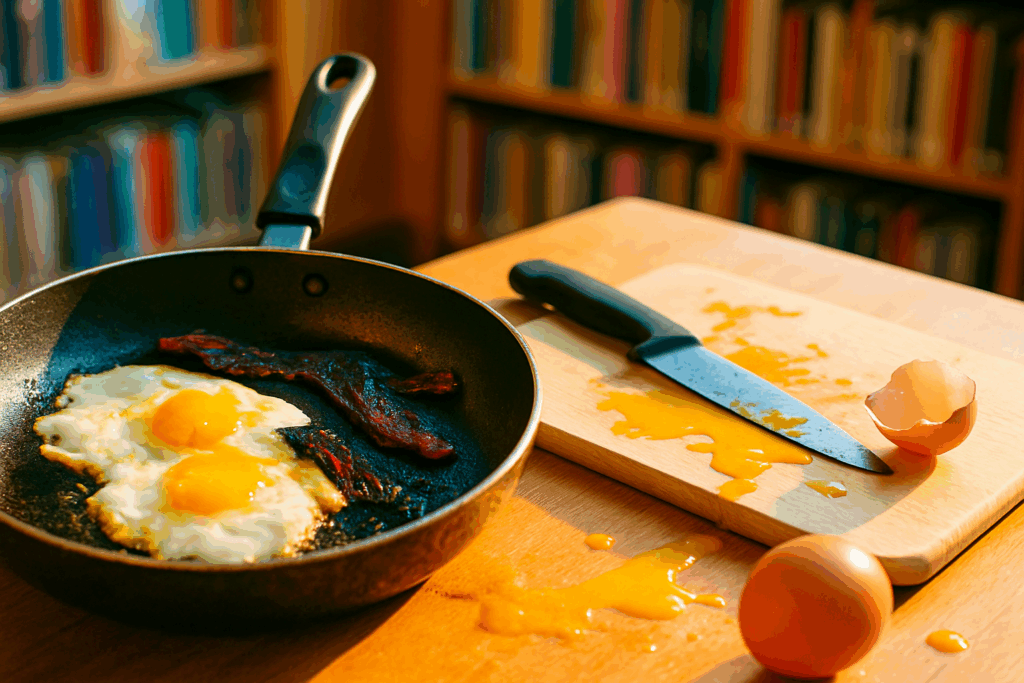Overcrowding the Pan
Overcrowding the pan is one of the most common mistakes home cooks make and it can sabotage your dish in seconds. Whether you’re sautéing vegetables or searing meat, giving your ingredients enough space is key.
Why It’s a Problem
When you load too much food into a pan at once:
Steam replaces sear: Instead of browning, your food releases moisture and begins to steam.
Texture suffers: You lose that golden crust and end up with soggy or unevenly cooked results.
Heat drops fast: Crowding the pan can lower the temperature, preventing proper flavor development.
How to Fix It
The solution is simple, even if it slows you down:
Cook in batches: Brown ingredients in smaller groups, then combine them later.
Let the pan recover heat between batches if needed.
Use a holding plate: Keep cooked items warm by setting them aside on a plate loosely covered with foil.
Choosing the Right Pan Size
A good pan can make all the difference:
10 to 12 inch skillet: Great for most home sized sauté jobs (1 2 servings).
Large sauté pan or dutch oven: Ideal for stews, stir fry, and family style meals.
Sheet pans: Perfect for roasting meats or veggies evenly in the oven use multiple pans if needed.
Being patient and intentional with pan space leads to better flavor, crispier textures, and more professional results.
Not Preheating Your Pan or Oven
Preheating may seem like an optional step, but skipping it can throw off the entire cooking process. From uneven textures to unpredictable cooking times, the consequences of not starting with a hot surface are bigger than most home cooks realize.
Why Preheating Matters
When heat isn’t consistent from the beginning, your food starts cooking unevenly. Instead of achieving the desired sear or rise, you may end up with soggy veggies, rubbery meat, or undercooked baked goods.
In pans: Cold pans prevent proper browning, which is crucial for building flavor.
In ovens: An unheated oven can ruin baked goods that rely on precise heat for rising and texture.
How Preheating Affects Texture & Timing
Texture: A hot start helps lock in moisture, create crispy edges, and develop a proper crust or sear.
Timing: Recipes assume you’re starting with preheated equipment. Deviating changes the entire cook time and outcome.
Tips for Proper Preheating
To get the most from your ingredients, follow these basic guidelines:
Pan Preheating
Heat your pan for 2 to 4 minutes over medium heat before adding oil or ingredients.
To test: Splash a few drops of water if they sizzle and evaporate quickly, it’s ready.
Oven Preheating
Most ovens take 10 to 15 minutes to fully preheat to a standard 350°F (175°C).
Use an oven thermometer to verify accuracy many ovens run hot or cold.
Wait for the indicator “preheat” light or alert before placing food inside.
Don’t rush this step letting your cookware come to temp ensures your food does what it’s supposed to.
Ignoring Your Knife Game

A dull knife isn’t just annoying it’s dangerous. You press harder, slip more, and end up bruising your ingredients and risking your fingers. Sharp blades make for cleaner cuts, faster prep, and safer hands.
It starts with the basics: grip the handle firmly, keep your guiding knuckles forward, and slice with a rocking motion don’t just chop straight down. The right angle depends on the knife and task, but aim for control over speed.
Maintenance is non negotiable. Hone your knife regularly to keep the edge aligned, and sharpen when it starts to drag. Wash, dry, and store it properly tossing it in a drawer with other utensils ruins the blade fast.
Want step by step technique? Dive into Knife Skills 101: How to Chop, Dice, and Slice Like a Pro. This is one of those skills that pays dividends every time you cook.
Under Seasoning or Over Seasoning
Recipes are a guide, not gospel. Tasting as you cook isn’t just a good habit it’s how good food happens. Flavors shift as ingredients break down, reduce, or meld. What worked at the start may need tweaking at the finish. Taste early, taste midway, taste before you plate. Don’t guess confirm.
Salt is where most mistakes happen. Add it too late, and your dish tastes flat. Too early, and it might get harsh or draw out too much moisture. Learn the basics: kosher salt for general cooking, flaky salt for finishing, fine salt sparingly. If you overdo it, don’t panic balance it out with acid (like lemon juice or vinegar), add starchy ingredients (like rice or potatoes), or stretch the dish with more volume.
Flavor isn’t just salt, though. Use acids to brighten think citrus, vinegars, fermented things. Herbs offer freshness; spices bring depth. Layer them. Don’t dump everything at once. Start with the base onions, garlic, spices then build up. A squeeze of lime at the end can change everything.
Rushing the Cooking Process
Cranking the heat isn’t a shortcut it’s a gamble. High flame can give you a charred outside and a raw center. Pasta that’s a mushy mess. Burnt garlic before the onions even soften. Cooking isn’t just about firepower; it’s about control.
Then there’s rest time. Skip it, and you’ll know. Meat bleeds out and loses moisture. Bread collapses. Pasta clumps instead of soaking in the sauce. Let your food breathe. Resting allows flavor to settle, texture to lock in, and temperature to even out.
Speed has its place in the kitchen, but it doesn’t replace judgment. Give your dish what it actually needs. Sometimes that’s more time, not more heat. Honor the pace, and the result honors you back.
Bonus Pro Tip for 2026
There’s a smart gadget for just about everything now oven cameras, auto stir fryers, app connected thermometers. They help, no question. But they can’t smell when garlic goes from golden to burnt. They won’t notice when a sauce breaks because you rushed the butter.
Cooking is still a sensory act. Your eyes catch the first signs of a simmer. Your nose tells you when onions are perfectly caramelized. Taste confirms if the seasoning’s really there. Texture? That’s all hands and heat.
So use the tools, but don’t lean on them. The best cooks stay alert, tune in to the food, and trust themselves over the screen. Stay sharp, stay patient, and let flavor take the lead.
